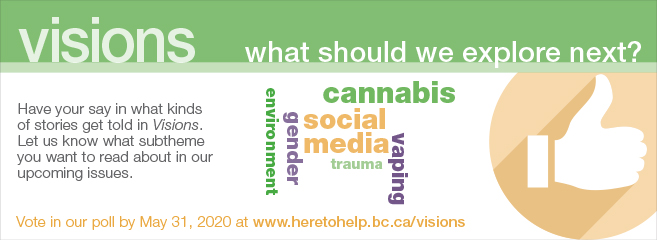Reprinted from the "Youth Facing Health Inequities" issue of Visions Journal, 2020, 15 (3), p. 4
Whether youth and young adults are Indigenous, racialized, LGBTQ2S+, homeless, living with a disability, in government care, involved with the justice system, or one or more of these, it's clear many young people face health inequities: unequal access to appropriate help and the social conditions that could help them get a stable foundation. This issue could have been titled a lot of things: "vulnerable youth," "marginalized youth," "at-risk youth," "underserved youth," "disadvantaged youth," "youth facing additional barriers"... Each of these terms is problematic though. At risk of what? Vulnerable to what? Aren't we all vulnerable in different ways to mental health and substance use problems? Isn't expressing vulnerability also an asset? "Additional barriers" implies that the mental health and substance use service systems, by default, have barriers built in for everyone—so that doesn't quite feel right either. The problem is all these terms tend to put the focus on young people instead of on the systems and supports that have let them down or discriminated against them.
This is one of the hardest issues we've ever had to produce, but not because of a shortage of stories or a shortage of courage—far from it. Young people of any persuasion are, well, busy and have lots on the go; many are in school, working, volunteering—"adulting" as they say—and with active social and recreational lives. ("Goody! Another written assignment!" said no young person ever.) But when you have more complex layers to your identity, more trauma and anxiety, and often even fewer supports, it also means sharing your story with a mental health magazine is, frankly, even less of priority. Young people we have pushed to the margins are also naturally more wary. They've been hurt before. Why should they trust us? Often we had to go through agencies who work directly with youth; those agencies are also busy, without much time and urgency to get to know us very well. And why should they? They don't owe us anything.
A huge and humble thank you to those who tried to solicit or submit even if it didn't quite work out. We know it was a hard ask. And we are also grateful to all the young people featured in the pages ahead (and their supporters) for giving us a chance and sharing their stories with such power and eloquence. Your passion, resilience, leadership and activism are truly inspiring. (#humbled)

About the author
Sarah is Visions Editor and Director of Mental Health Promotion at the Canadian Mental Health Association’s BC Division
